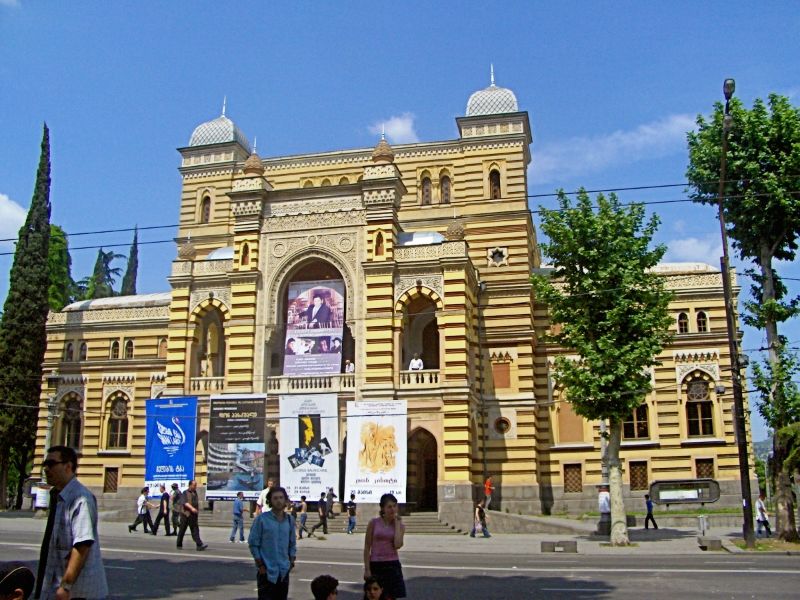
A visit to the Tbilisi Opera and Ballet Theater is the brightest event for admirers of beautiful, professionally performed music, opera arias and passionate Georgian ballet.
The capital’s theater will also give a charming and unforgettable experience to those who are not keen on opera or ballet. After all, a building designed in the pseudo-Moorish style, a labyrinth of tiers, a beautiful, cozy and pompous interior, expositions, a solemn concert hall, the opportunity to see the capital’s Georgian intelligentsia – all this will not leave anyone indifferent.
And there will also be opera or ballet, beautiful costumes and scenery, and a special, rich sound of a symphony orchestra.
Having visited the opera house, you will discover another facet of Georgia and see that this country is not only wine, khinkali and khachapuri.
The theater is located in the very center of Tbilisi – on Shota Rustaveli Avenue at number 25.
Theater tickets are inexpensive and easily purchased online. You do not need to print tickets – just show the QR code from your phone.
Website: http://opera.ge
Tbilisi Opera and Ballet Theater is a member of Opera Europa. It is part of the European Route of Historic Theaters and is supported by the Cultural Program of the European Union. More than 700 people of the team will guide you through really high art and give you an unforgettable holiday.
The history of the opera theater in Tbilisi is 170 years old.
On April 15, 1847, on the site of a recently filled ravine on Erivan Square, the foundation was laid for the so-called Caravanserai theater, designed for 800 spectators. The construction of the Theater building under the direction of the Italian architect Scudieri lasted four years.
On April 12, 1851, the grand opening of the first opera house in Transcaucasia took place with a masquerade ball, which was attended by the high society of Tbilisi.
On October 25 of the same year, the popular Parisian newspaper “L’Illustration” published a large article by Edmond de Bar with two photographs of the interior of the theater. The author wrote: “This is the only theater in the city, the interior of which is completely Moorish in style, and is undoubtedly one of the most elegant, beautiful and fascinating theatrical structures perceived by man.”
On November 9, 1851, a specially invited Italian troupe, directed by Barbieri, opened the first theatrical season in Tbilisi with the opera Lucia di Lammermoor by Gaetano Donizetti.
After the performance, which was a great success, the owners took Barbieri and the troupe to the left bank of the Mtkvari (Kura) River for a national feast, where they celebrated on boats all night.
On October 1, 1874, the Tbilisi Opera House burned down. The merchant Kazarov, accused of arson, was sentenced to 9 years in prison in Siberia. But there were also suggestions about the involvement of top administrators. The opera moved to the “summer stage” for 22 years. The performances of the opera troupe continued, but already in a room unsuitable for this on Vodovoznaya Street.
In 1896, on Golovin Avenue (now Rustaveli Avenue), the construction of a new Opera House was completed according to the project of architect Viktor Schroeter. The new building was designed for 1200 seats (the current building of the Opera House).
The performance of Zakaria Paliashvili “Abesalom and Eteri” traditionally opened the season. Since 1937, the Opera House has been named after the Georgian classic and great composer Zakaria Paliashvili.
In 1973, a fire broke out in the theater again and almost all the interior decoration of the building was destroyed, and already in 1978 the theater building was restored to its original form.
The authors of the reconstruction – architects Leri Medzmariashvili and Murtaz Chachanidze managed to preserve the eastern, pseudo-Moorish style of the building. Six rehearsal rooms were made (three of them for ballet, two for opera and one for orchestra).
Vocal and chamber concerts, exhibitions and various kinds of meetings were held in the foyer of the theater and in three wonderful halls.
In 2010, a large-scale international theater renovation project was launched. The foundation was strengthened, the roof was covered with copper sheets, the stage mechanism and the theater equipment were updated, the hall was re-gilded and the orchestra pit was enlarged, the rehearsal hall was rebuilt, open verandas and exhibition spaces were added.
The square around the theater was expanded, where the composer Zakaria Paliashvili, tenors Vano Sarajishvili and Zurab Anjaparidze and conductor Odysseus Dimitriadi are buried.
The “visiting card” of the theatre, the cult curtain by Sergo Kobuladze that burned down in the fire, returned to the stage recreated.
In addition, state-of-the-art video and audio and lighting systems were installed, and a hundred-candle crystal chandelier was restored in Austria. The theater was fully equipped with new furniture, and modern details were added: open verandas, an exhibition hall and a dining room. The dressing rooms and the lounge have been refurbished.
Renovated Tbilisi Opera and Ballet Theatre. Zakaria Paliashvili once again opened the doors to the audience!

